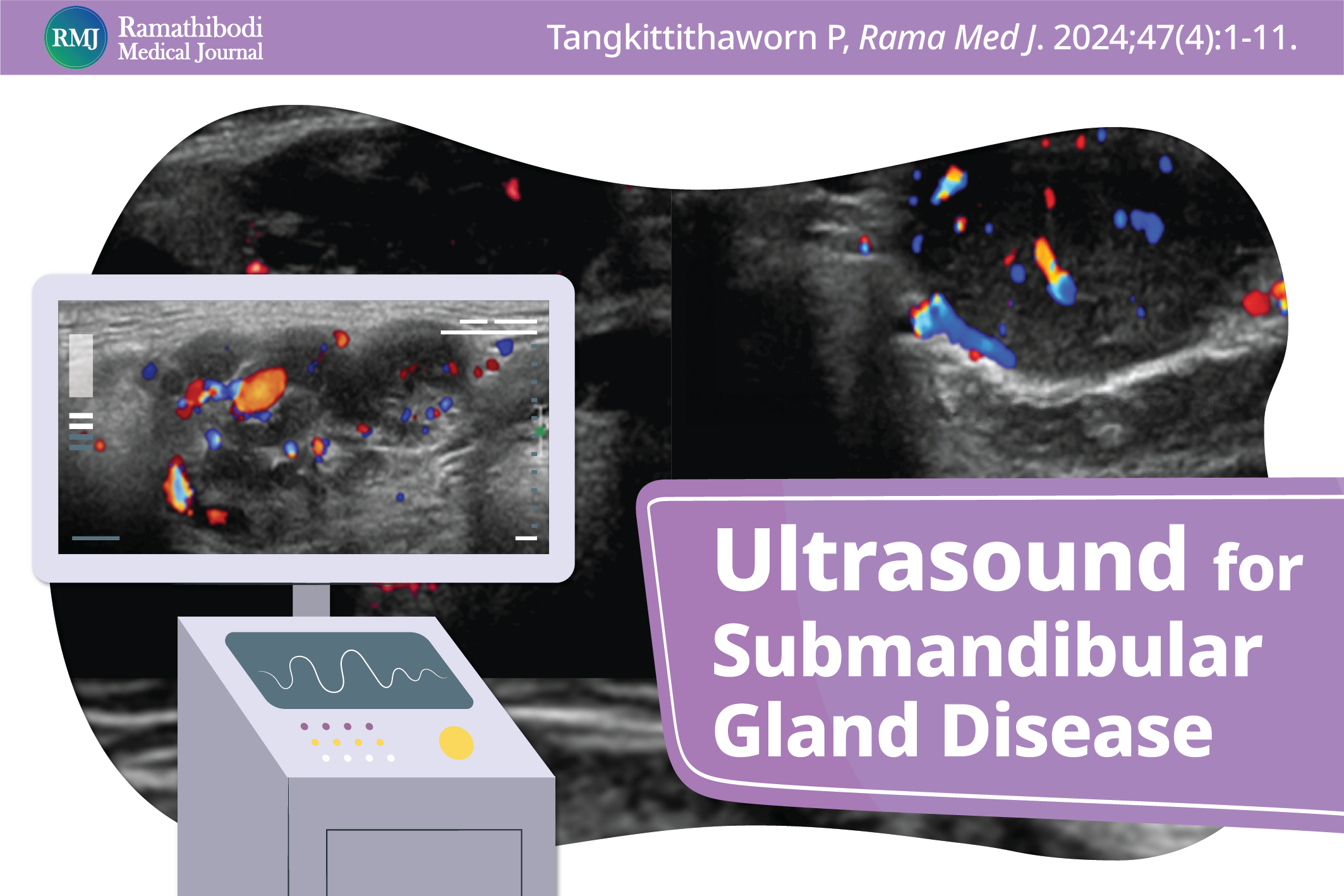Ultrasound in Patients With Clinically Suspected Submandibular Gland Disease
DOI:
https://doi.org/10.33165/rmj.2024.47.4.270410Keywords:
Submandibular gland, Submandibular disease, Salivary, Ultrasound, Sjögren syndromeAbstract
Background: The submandibular gland is quite common to be affected by various disease processes in all age groups that may be difficult to differentiate clinically. Its superficial location makes it readily accessible to ultrasound evaluation.
Objective: To evaluate sonographic features of abnormal submandibular gland.
Methods: Ultrasound images and medical records of patients who presented with clinically suspected submandibular gland disease at a single institution were retrospectively reviewed. Demographic data, final diagnoses, further management, and sonographic findings were evaluated.
Results: Eighty-one patients were identified, 56 females and 25 males (mean [SD] age, 53 [16] years; range, 1 - 87 years). The main presenting symptoms were palpable mass (31 [38.3%]) and pain (23 [28.4%]) involving the left (30 [37.0%]), the right (27 [33.3%]), and bilateral submandibular area (24 [29.6%]). Only 6 patients (8.1%) underwent further imaging. The most common final diagnoses were acute sialadenitis (38 [46.9%]), Sjögren syndrome (14 [17.3%]), tumor (6 [7.4%]), and stone (4 [4.9%]). Submandibular glands were normal in 17 of 81 patients (21%); 9 of 17 (52.9%) had abnormal lymph nodes. Among various disease entities, a significant correlation was found between Sjögren syndrome and small gland size, stone and ductal dilatation, and abnormal lymph nodes with enlarged nodal size (P < .001).
Conclusions: Two-thirds of the patients had inflammatory/infectious diseases, with tumor and stone in minority. Certain ultrasound findings can suggest diagnosis. Less than 10% underwent further imaging, suggesting that ultrasound can be used to detect and guide further management of submandibular disease.
References
Bialek EJ, Jakubowski W, Zajkowski P, Szopinski KT, Osmolski A. US of the major salivary glands: anatomy and spatial relationships, pathologic conditions, and pitfalls. Radiographics. 2006;26(3):745-763. doi:10.1148/rg.263055024
Rabinov JD. Imaging of salivary gland pathology. Radiol Clin North Am. 2000;38(5):1047-1057. doi:10.1016/s0033-8389(05)70220-7
Gadve V, Mohite A, Bang K, Shenoi SR. Unusual giant sialolith of Wharton’s duct. Indian J Dent. 2016;7(3):162-164. doi:10.4103/0975-962X.174594
Howlett DC, Alyas F, Wong KT, et al. Sonographic assessment of the submandibular space. Clin Radiol. 2004;59(12):1070-1078. doi:10.1016/j.crad.2004.06.025
Lorenzon M, Spina E, Tulipano Di Franco F, Giovannini I, De Vita S, Zabotti A. Salivary gland ultrasound in primary Sjögren’s syndrome: current and future perspectives. Open Access Rheumatol. 2022;14:147-160. doi:10.2147/OARRR.S284763
Straughan AJ, Badger CD, Benito DA, Joshi AS. Salivary gland ultrasound training: improving anatomic identification in residents. Am J Otolaryngol. 2020;41(6):102734. doi:10.1016/j.amjoto.2020.102734
Katz P, Hartl DM, Guerre A. Clinical ultrasound of the salivary glands. Otolaryngol Clin North Am. 2009;42(6):973-1000. doi:10.1016/j.otc.2009.08.009
Gritzmann N, Rettenbacher T, Hollerweger A, Macheiner P, Hübner E. Sonography of the salivary glands. Eur Radiol. 2003;13(5):964-975. doi:10.1007/s00330-002-1586-9
Alyas F, Lewis K, Williams M, et al. Diseases of the submandibular gland as demonstrated using high resolution ultrasound. Br J Radiol. 2005;78(928):362-369. doi:10.1259/bjr/93120352
Garg K, Kapila S, Gulati A, Azad RK, Thakur JS. Sonographic and cytological evaluation of salivary gland Tumors. Indian J Otolaryngol Head Neck Surg. 2023;75(4):3427-3431. doi:10.1007/s12070-023-04020-9
Choi I, Na DG, Paik W. Ultrasonographic echogenicity of normal salivary glands in adults: comparison of submandibular and parotid glands. Ultrasonography. 2021;40(3):342-348. doi:10.14366/usg.20070
Baldini C, Zabotti A, Filipovic N, et al. Imaging in primary Sjögren’s syndrome: the ‘obsolete and the new’. Clin Exp Rheumatol. 2018;36 Suppl 112(3):215-221.
Salaffi F, Argalia G, Carotti M, Giannini FB, Palombi C. Salivary gland ultrasonography in the evaluation of primary Sjögren’s syndrome. comparison with minor salivary gland biopsy. J Rheumatol. 2000;27(5):1229-1236.
Lanjekar A, Kukde MM, Madne I, Deotale KR, Bankar NJ. Pivotal role of ultrasonography and radiology in diagnosing a case of sialolith. Cureus. 2023;15(12):e51269. doi:10.7759/cureus.51269
Zengel P, Schrötzlmair F, Reichel C, Paprottka P, Clevert DA. Sonography: the leading diagnostic tool for diseases of the salivary glands. Semin Ultrasound CT MR. 2013;34(3):196-203. doi:10.1053/j.sult.2012.11.012
Marchal F, Kurt AM, Dulguerov P, Lehmann W. Retrograde theory in sialolithiasis formation. Arch Otolaryngol Head Neck Surg. 2001;127(1):66-68. doi:10.1001/archotol.127.1.66
Gritzmann N. Sonography of the salivary glands. AJR Am J Roentgenol. 1989;153(1):161-166. doi:10.2214/ajr.153.1.161
Orloff LA, Hwang HS, Jecker P. The role of ultrasound in the diagnosis and management of salivary disease. Oper Tech Otolaryngol -Head Neck Surg. 2009;20:136-144.
Tassoker M, Ozcan S. Two cases of submandibular sialolithiasis detected by cone beam computed tomography. IOSR J Dent Med Sci. 2016;15(8):124-129. doi:10.9790/0853-150810124129
Yousem DM, Kraut MA, Chalian AA. Major salivary gland imaging. Radiology. 2000;216(1):19-29. doi:10.1148/radiology.216.1.r00jl4519
Koischwitz D, Gritzmann N. Ultrasound of the neck. Radiol Clin North Am. 2000;38(5):1029-1045. doi:10.1016/s0033-8389(05)70219-0

Downloads
Published
How to Cite
Issue
Section
License
Copyright (c) 2024 by the Authors. Licensee Ramathibodi Medical Journal.

This work is licensed under a Creative Commons Attribution-NonCommercial-NoDerivatives 4.0 International License.
















